
On this day in Tudor history, 19th January 1601, Henry Herbert, 2nd Earl of Pembroke, died at Wilton, the family home near Salisbury.
Who was Henry Herbert?
Let me tell you about this interesting Tudor man in today’s talk.
[Read More...]
On this day in Tudor history, 19th January 1601, Henry Herbert, 2nd Earl of Pembroke, died at Wilton, the family home near Salisbury.
Who was Henry Herbert?
Let me tell you about this interesting Tudor man in today’s talk.
[Read More...]
On this day in Tudor history, 13th January 1599, Elizabethan poet and administrator in Ireland, Edmund Spenser, died in Westminster. He was described as “the prince of poets in his time” and is best known for his allegorical poem in praise of Elizabeth I, “The Faerie Queene”.
But, did you know that he also upset William Cecil twice and that his most famous work is actually unfinished?
Find out more about Edmund Spenser in today’s talk.
[Read More...]
On this day in Tudor history, Thursday 12th January 1559, Queen Elizabeth I travelled by barge from Whitehall to the Tower of London to prepare for her coronation, which was due to take place on the 15th January.
Of course, her journey wasn’t a low key one in a normal river barge, it was a lavish one with decorated barges, music and the usual artillery fire. Find out all about this river procession in today’s talk.
[Read More...]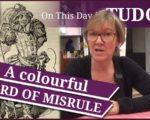
On this day in Tudor history, 11th January 1579, courtier, Member of Parliament, Lord of Misrule and poet, George Ferrers, was buried at Flamstead, Hertfordshire.
Ferrers was a rather colourful Tudor character. He caused a stir when he was arrested on his way to the House of Commons (the Ferrers’ Case), he was Lord of Misrule on several occasions and led a huge procession into London, and he had a hand in the arrest of John Dee. And that’s not all!
Find out all about George Ferrers in today’s talk.
[Read More...]
Happy Epiphany! Happy Kings’ Day! Yes, today is the Feast of the Epiphany, the day that commemorated the visit of the Magi to the Christ Child.
Following on from yesterday’s Teasel’s Tudor Trivia about Epiphany Eve and Twelfth Night Cake, I thought I’d share with you some examples of how Epiphany was celebrated at the royal court. Find out what those Tudor people got up to on Twelfth Night in today’s talk.
[Read More...]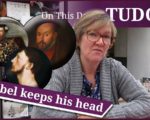
On this day in Tudor history, 4th January 1575, in the reign of Queen Elizabeth I, courtier, diplomat and former rebel, Sir William Pickering, died at his home, Pickering House, in London.
He died a wealthy man and died a natural death, a miraculous feat seeing as he was a friend of the Earl of Surrey and the Duke or Northumberland, both of whom ended up on the scaffold, AND he was one of the men involved in planning Wyatt’s Rebellion in 1554. Wyatt lost his head, but Pickering kept his.
How? What happened? Find out more about Sir William Pickering in today’s talk.
[Read More...]
On this day in Tudor history, 2nd January 1536, imperial ambassador, Eustace Chapuys, visited his good friend, Catherine of Aragon, first wife of King Henry VIII and a woman who was now officially called the Dowager Princess of Wales.
Catherine was seriously ill, in fact, she was dying, and this would be the last time that Chapuys saw her.
Find out from Chapuys’ own account what happened in the four days he spent with Catherine of Aragon.
[Read More...]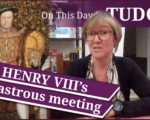
In today’s “on this day in Tudor history talk”, Claire Ridgway, author of several Tudor history books, puts you out of your misery from the cliffhanger she left you with on 27th December, by telling you all about Henry VIII’s first meeting with his bride-to-be, Anne of Cleves, on 1st January 1540.
This meeting between King Henry VIII and the woman who would soon become his fourth wife, was a bit of a disaster, but exactly how much of a disaster was it? The accounts differ and in the video I share two slightly different contemporary accounts, one given in a chronicle and one shared in the annulment proceedings a few months later in 1540.
What happened on New Year’s Day 1540 at Rochester? Find out all about Henry VIII and Anne of Cleves’ first meeting in today’s talk.
[Read More...]
On this day in Tudor history, 31st December 1559, Owen Oglethorpe, Bishop of Carlisle, died while under house arrest in London. He was buried at St Dunstan-in-the-West on 6th January 1560.
Oglethorpe is known for officiating at Queen Elizabeth I’s coronation in 1559, but also for infuriating the queen at Christmas 1558 by disobeying her instructions at Mass.
What did Oglethorpe do?
Find out about Owen Oglethorpe’s life and career, and how he upset the queen and ended his days under house arrest, in today’s talk.
[Read More...]
Merry Christmas! A very Happy Christmas to you and yours!
In today’s talk, I explain how Tudor people would have celebrated Christmas, before moving on to today’s “on this day” event, the death of Lettice Blount (also known as Lettice Devereux, Lettice Dudley and Lettice Knollys). Not only did she serve Queen Elizabeth I as a gentlewoman of the privy chamber, she was also the queen’s first cousin once removed, and was nicknamed the “she-wolf” by her royal mistress. Find out more about Lettice Knollys in today’s talk.
[Read More...]
On this day in Tudor history, 24th December 1545, Christmas Eve, King Henry VIII made his final speech to Parliament.
The king was concerned about the religious divisions in his realm and so chastised the Lords and Commons for their disagreements, and also the clergy for provoking this discord.
In today’s talk, I share some of the king’s compelling speech from that day in 1545.
[Read More...]
On this day in Tudor history, 19th December 1576, Katherine Palmer, Abbess of Syon, died in Mechelen in Belgium. Her death came just over a month after she had confronted a mob that had broken into her monastery.
Find out more about Abbess Katherine Palmer, how her order had ended up settling in Mechelen, and how her order is the only surviving pre-Reformation religious community in England today, in this talk.
[Read More...]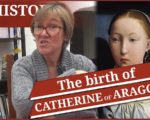
Happy birthday to Catherine of Aragon! Yes, this first wife of King Henry VIII and Spanish princess was born on this day in Tudor history, 16th December 1485.
In today’s talk, I explain Catherine of Aragon’s background, give some insights into her early life, and talk about how she ended up leaving her homeland of Spain and eventually becoming queen consort to Henry VIII.
[Read More...]
On this day in history, 11th December 1608, one of Queen Elizabeth I’s former ladies and a lover of Robert Dudley, Earl of Leicester, was buried at St Margaret’s Church, Westminster. Her name was Douglas Sheffield (née Howard), Lady Sheffield, and she was the mother of Leicester’s illegitimate son, Sir Robert Dudley.
Find out more about Douglas Sheffield, who claimed to be Leicester’s legal wife, in today’s talk.
[Read More...]
Today, 6th December is the Feast of St Nicholas, or St Nicholas of Myra, the 4th century Bishop of Myra. In medieval and Tudor times, it was the traditional day for the election of a boy bishop would undertake all of the duties of a bishop from the 6th December until 28th December, Childermas (Holy Innocents’ Day).
You can find out about the tradition of Boy Bishop, and how and why Henry VIII put an end to it, and how it’s been revived today, in today’s talk from Claire Ridgway, founder of the Tudor Society.
[Read More...]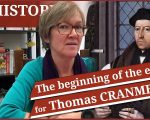
On this day in Tudor history, 4th December 1555, in Rome, papal sentence was passed on Thomas Cranmer, resulting in Cranmer being deprived of his archbishopric. Permission was also granted for his fate to be decided by the secular authorities.
In today’s “on this day in history”, I explain what led Cranmer to this day and also what happened next. Thomas Cranmer went on to recant his Protestant faith on several occasions, but was still executed by being burned at the stake. Why?
Find out more in today’s talk.
[Read More...]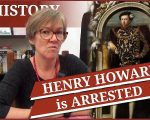
On this day in Tudor history, 2nd December 1546, Henry Howard, Earl of Surrey, poet, courtier, soldier and the eldest son of Thomas Howard, 3rd Duke of Norfolk, was arrested after Richard Southwell, his former friend, gave evidence against him.
King Henry VIII had just weeks to live and was increasingly paranoid, so Southwell’s ‘evidence’ was just what Surrey’s enemies needed to bring the earl down.
Find out more about the Earl of Surrey’s downfall, and how his father managed to keep his head, in today’s talk.
[Read More...]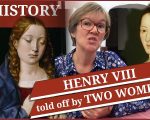
On this day in Tudor history, 30th November 1529, the feast of St Andrew, Henry VIII was reproached by the two women in his life: his wife, Catherine of Aragon, and the woman he wanted to marry, Anne Boleyn.
Catherine of Aragon was not impressed by the way her husband was treating her, and Anne Boleyn didn’t like the fact that the king was letting Catherine get the upper hand. They both told the king exactly what they thought. It was not a good day for King Henry VIII.
Find out exactly what happened with Henry VIII, Catherine of Aragon and Anne Boleyn on this day in 1529, in today’s talk.
[Read More...]
On this day in Tudor history, 29th November 1530, at around 8 o’clock in the morning, Cardinal Thomas Wolsey, Henry VIII’s former Lord Chancellor, died at the Abbey of St Mary de Pratis, Leicester.
Cardinal Wolsey, who was in his fifties, cheated the executioner by dying a natural death while on his way to London to answer charges of treason. He surely would have been tried and executed had he reached the capital.
Find out about Cardinal Wolsey’s death, and who ended up being buried in the sarcophagus he’d had commissioned, in today’s talk.
[Read More...]
On this day in Tudor history, 28th November 1499, Edward Plantagenet, styled Earl of Warwick, was executed by beheading on Tower Hill.
Warwick was a potential claimant to the throne being the son of George, Duke of Clarence, brother of Kings Edward IV and Richard III, but it was his involvement in a plot by pretender Perkin Warbeck that was his final undoing.
Find out more about his short and sad life, much of it spent in prison, in today’s talk:
[Read More...]
On this day in Tudor history, 27th November 1582, eighteen year-old William Shakespeare, the famous playwright and a man known as the Bard, married twenty-six year-old Anne (also known as Agnes) Hathaway, at Temple Grafton, near Stratford-upon-Avon, in Warwickshire.
Anne Hathaway was pregnant at the time of their marriage and went on to give birth to a daughter, Susannah, the following May. The couple went on to have twins, Hamnet and Judith, in 1585.
Find out more about William Shakespeare and Anne Hathaway, and their marriage, and also what happened to them, in today’s talk:
[Read More...]
On this day in Tudor history, Saturday 24th November 1487, the coronation procession of Elizabeth of York, queen consort of King Henry VII, the first Tudor monarch, took place in London.
Elizabeth of York’s coronation was scheduled for the next day. She had become queen in January 1486, but her coronation had been postponed due to pregnancy and trouble with the Cornish rebels and Perkin Warbeck. Finally, Henry VII’s wife and the mother of little Prince Arthur could be crowned queen.
Find out all about her coronation procession, what Elizabeth wore, who was involved and what happened, in today’s talk.
[Read More...]
Note: I say that Margaret of York was the Princes’ sister, when actually she was their aunt. Sorry!
On this day in Tudor history, 23rd November 1499, in the reign of King Henry VII, pretender Perkin Warbeck was hanged at Tyburn after allegedly plotting to help another claimant, Edward, Earl of Warwick, escape from the Tower of London.
Perkin Warbeck had claimed to be Richard of Shrewsbury, Duke of York, the younger of the Princes in the Tower, and had even been proclaimed King Richard IV, but his rebellion and claim failed.
In today’s talk, I give Perkin Warbeck’s background, and explain how he ended up trying to claim the throne of England, and what happened.
[Read More...]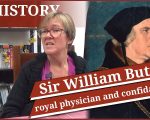
On this day in Tudor history, 22nd November 1545, Henry VIII’s trusted physician and confidant, Sir William Butts, died after suffering from a “dooble febre quartanz”, a form of malaria.
Sir William Butts was the doctor who was sent to treat Anne Boleyn, when she was ill with sweating sickness, and also advised on Princess Mary’s sickness, and was the man King Henry VIII confided in about his problems consummating his marriage to Anne of Cleves. He was obviously a man the king could trust.
Find out more about this Tudor physician in today’s talk, with help from Teasel the dog.
[Read More...]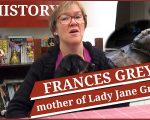
On this day in Tudor history, 21st November 1559, Frances Grey (maiden name Brandon, other married name Stokes), Duchess of Suffolk and the mother of Queen Jane, or Lady Jane Grey, died at Richmond. She was laid to rest in St Edmund’s Chapel, Westminster Abbey, on the orders of her cousin, Queen Elizabeth I, and her second husband, Adrian Stokes, erected a tomb in her memory.
Frances, daughter of Charles Brandon, Duke of Suffolk, and Mary Tudor, Queen of France, has gone down in history as rather a harsh and abusive mother, but let me tell you a bit more about the woman who was once named in Edward VI’s “devise for the succession”.
[Read More...]
On this day in Tudor history, 15th November 1532, a rather cross Pope Clement VII threatened King Henry VIII and Anne Boleyn with excommunication.
Why? Well, because Henry VIII had defied the pope’s instructions and previous threats, and gone his own way, setting aside Catherine of Aragon and living with Anne Boleyn. The pope was not impressed with this disobedient king.
In today’s talk,I share excerpts of the pope’s letter, along with an explanation of the context and what happened next.
[Read More...]
On this day in Tudor history, 12th November 1537, the corpse of Queen Jane Seymour, Henry VIII’s third wife, was transported by chariot in a procession from Hampton Court Palace to Windsor Castle, in preparation for burial. Jane Seymour’s heart and entrails had been buried in the chapel at Hampton Court Palace following her death on 24th October 1537.
Queen Jane’s stepdaughter, the Lady Mary, acted as chief mourner for the proceedings.
There was also a commemoration for Queen Jane in the city of London.
[Read More...]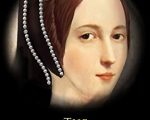
Claire here! As you have probably noticed, Anne Boleyn is my very favourite historical character. Now, I know that she doesn’t interest you all, but the latest in my collection of articles, The Anne Boleyn Collection III, which is available for pre-order right now, also covers some other historical topics.
Here’s the blurb:
Claire Ridgway, best-selling author and creator of the Anne Boleyn Files website, celebrates the 10th anniversary of her site with this collection of articles on Anne Boleyn, second wife of King Henry VIII, and Tudor history.
Written in Claire’s easy-going style, but with an emphasis on good history and sound research, The Anne Boleyn Collection III is perfect reading for Tudor history lovers everywhere. Myths, popular misconceptions and inaccuracies, are all challenged by Claire using contemporary evidence.
[Read More...]
On this day in Tudor history, 31st October 1517, Reformer, priest and professor of theology Martin Luther is said to have posted his 95 Theses on the door of the Castle Church in Wittenberg, although all we know for definite is that he posted them to Bishop of Brandenburg and the Archbishop of Mainz.
The proper title of his work was the “Disputation of Martin Luther on the Power and Efficacy of Indulgences”, and he was protesting against the sale of indulgences by the papacy, as well as other points. His actions on this day had a huge impact on Europe and were the catalyst of the European Reformation.
Find out more about Martin Luther’s 95 Theses and what happened next in today’s video.
[Read More...]
This day in Tudor history, Monday 28th October 1532, the Feast of St Simon and St Jude, was the last full day of Henry VIII and Anne Boleyn’s time with King Francis I of France in Calais, and it was time to celebrate the kings’ friendship.
New Knights of the Garter were elected, bear-baiting was watched and then there was a wrestling match between French and English men, but who would win? Find out what happened in today’s talk. I also explain the Feast of St Simon and St Jude.
[Read More...]